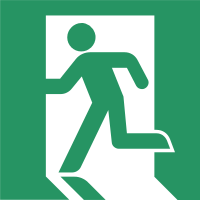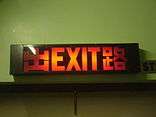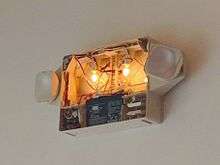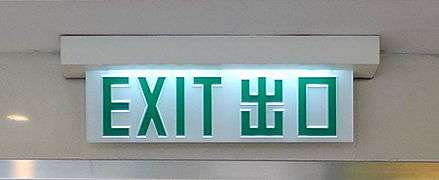Exit sign
- For the sign located on a controlled-access highway, see Exit number.

ISO Standard (1987) sign in parts of Asia-Pacific, Europe and Canada; actual implementations vary slightly
.svg.png)


An exit sign is a device in a public facility (such as a building, aircraft or boat) denoting the location of the closest emergency exit in case of fire or other emergency.
Most relevant codes (fire, building, health or safety) require exit signs to be permanently lit.
Exit signs are designed to be absolutely unmistakable and understandable to anyone. In the past this generally meant exit signs that show the word "EXIT"[2] or the equivalent in the local language, but increasingly exit signs around the world are in pictogram form, with or without text supplement.[3]
History


Early exit signs were generally either made of metal and lit by a nearby incandescent light bulb[4] or were a white glass cover with EXIT written in red that fit directly over a single-bulb light fixture. The inherent flaws with these designs were that, in a fire, the power to the light often failed. In addition, the fixtures could be difficult to see in a fire where smoke often reduced visibility, despite being relatively bright. The biggest problem was the exit sign being hardly distinguishable from an ordinary safety lighting fixture commonly installed above doors in the past. The problem was partially solved by using red-tinted globes instead.
Better signs were soon developed that more resembled today's modern exit sign, with an incandescent bulb inside a rectangular-shaped box that backlit the word "EXIT" on one or both sides. Being larger than its predecessors, this version of the exit sign solved some of the visibility problem. The sign was only useful as long as main power remained on.
As battery-backup systems became smaller and more efficient, some exit signs began to use a dual-power system. Under normal conditions, the exit sign was lit by mains power and the battery was in a charge state. In the event of a power outage, the battery would supply power to light the sign. It continued to discharge until mains power returned to the unit or the battery was no longer able to provide sufficient power to light the sign. Early battery-backup systems were big, heavy, and costly.[4] Modern systems are lightweight, can be installed virtually anywhere, and are integrated into the fixture, rather than requiring a separate box. As batteries improved, so did the amount of time that a fixture could remain lit on batteries.
While exit signs were more visible due to large letters, even a 60-watt bulb shown through a plastic or glass cover (see image), could appear somewhat dim under certain conditions. With the development of fluorescent lamp and light-emitting diode technology, exit signs could be made even brighter to show up in the limited visibility of a fire situation, or use less electricity. LED signs combine a large number of bright light-emitting diodes to illuminate the sign from inside. Fluorescent lamps work in the same way as incandescent bulbs, back-lighting both sides of an exit fixture from within. Because an exit sign is constantly lit, fluorescent bulbs need to be changed more often than LEDs, although the almost nonexistent on/off cycles extend the life of fluorescent lamps significantly. Generally, LEDs have a very long life, and may last for 10 years or more of continuous use, although the brightness may diminish. . Incandescent bulbs are still in use, because they are cheap and common, even though they use more electricity and require more or less frequent replacement. Bulbs lit 24/7 will have a greatly extended lifespan.
Decades ago, radioluminescent and phosphorescent signs that require no electricity have also been developed. These have been around since the 1970s. Radioluminescence uses the radioactive decay of tritium to light the sign,[5] while phosphorescence uses light-emitting phosphors to glow in the dark. While both of these signs meet California State Fire Marshall standards, where practical, electricity is used in the vast majority of signs.
Modern installations


Most exit signs in the world, except in countries such as the US, Australia, Hong Kong, Philippines, and Singapore are of pictogram type. Australia and Singapore have made changes to their respective life safety codes in the direction of pictogram use. In the US, New York City has endorsed a new code requiring high rises to have glow-in-the-dark exit signs with a pictogram (ISO). In Thailand, most exit signs are in any running-man pictogram (ISO).
Modern exit signs often can be seen indicating the path to an exit in commercial and large residential buildings that comply with fire code. Certain circumstances, such as the year a building was built, may leave it exempt from some of these codes. In most situations, the owner of the building is responsible for complying with exit sign requirements. This is especially true in older buildings that serve as multiple residences, such as apartment buildings, hotels, and campus dormitories. Modern fixtures are usually in a rugged plastic or metal housing securely bolted to the wall or ceiling. The signs have the word EXIT, or a picture representing exit, on both sides. Single-sided signs are also available for wall-mount installations. The signs often have metal or plastic knock-outs which can be removed so that an arrow is also lit pointing left or right.
Modern exit signs are often combined with other safety devices, such as emergency floodlighting. Exit signs draw a relatively small amount of power, and can generally be added onto any existing electrical circuit without adverse effects. Modern exit signs are also, to some degree, flame retardant.
In addition, specialized LED lamps with "candelabra" sized screw-in bases are available to replace the always-on incandescent lamps in older exit signs. This allows the existing fixtures to be upgraded to save energy, without the expense of complete replacement.
Most recently, LEC (light emitting capacitor) exit signs have come to market. Also called electroluminescent (EL), these signs only consume 1/4W of power with an operational life of 30+ years and far exceeding the typical 10-year life of an LED sign, LEC exit signs are a new option for architects and engineers.
Lighting


Since visibility may be reduced in a fire, due to smoke or failure of electric lighting, the sign is often permanently illuminated, usually by one of:
- Radioluminescence, self-luminous, where a phosphor coating inside a glass tube glows due to the beta decay of radioactive tritium in the tube. Radioluminescence exit signs are prohibited in US Department of Defense installations.[7]
- Photoluminescence ('glow in the dark'), Phosphorescence, where light is absorbed from the surroundings and slowly re-emitted.
- Electric light, with a local rechargeable power source.
- Electric light, with the building's emergency lighting circuits providing back-up power from a UPS or a generator in case normal power fails.
Color and design
In most regions, including the European Union, Australia, New Zealand, Japan, South Korea, and China, exit signs have green lettering. (In this color scheme, red is used to show prohibited activities.) In most European countries pictograms are used in place of the word "exit". European sign directive 92/58/EEC of 24 June 1992 indicates that the signs should be green in colour indicating a safe place of exit. BS EN 1838:1999, BS 5266-7:1999 also governs the emergency lighting applications.
In United States, exit signs can have either red or green lettering, but usually red. This is due to states or cities enacting building codes which specify the sign color. For example, in Baltimore, Salt Lake City, and Portland, Oregon, green is required. New York City, Rhode Island, and Chicago (along with the rest of Illinois) require that exit signs have red text.
New and renovated buildings in Canada are required to use the international standard green "running man" pictogram. The 1995 Canadian national building code required "red letters on a contrasting background or white letters on a red background ... spelling EXIT or SORTIE",[8] however the 2010 Code calls for a switch from the red EXIT signs to the green "running-man" signs.[9] The national building code informs provincial and municipal building codes but does not have legal status itself. Most Canadian jurisdictions require the international green "running-man" pictogram, however some have allowed red "EXIT" signs to be maintained in older properties so long as one style is used consistently throughout the building.[10]
Green fluorescent signs can be seen better in dark conditions than other colors, as the human rod cell is more sensitive to these wavelengths.[11][12]
Newly installed exit signs in Australia are green with white "running man" figure (AS2293).
Accessible designs
There is a trend towards providing a more accessible, socially inclusive exit sign design based on universal design principles, including consideration for people with disability in an overall exit sign strategy for a building or facility.
The Accessible Exit Sign Project started in Australia in 2014, has spread to New Zealand and the United States, and is an international awareness campaign that promotes the need for an accessible means of egress. Advocates proposes that appropriate exit signage to identify the accessible means of egress is a critical component to the successful emergency planning for any building.[13]
The proposed new exit sign design features an "Accessible Means of Egress Icon", which includes an adaptation of the "running man" symbol with a new wheelchair symbol. The design is considered an enhanced version of the ISO 7010 and ISO 21542 accessible exit sign that shows the "running man" and International Symbol of Access at the end of the sign. The universally inclusive design with the "running man" and 'Accessible Means of Egress Icon' wheelchair symbol essentially share the same upper torso, and the design shows the two moving through the door together. The Global Alliance on Accessible Technologies and Environments (GAATES) has stated that the introduction of the "Accessible Means of Egress Icon" onto exit signage changes the current discriminatory approach to emergency exit signs and presents a fully inclusive design.[14] "The combined ‘Running Man’ and ‘Accessible Means of Egress Icon’ shown above are working together to escape the building. They move in unison, display the same urgency and motion and appear to be travelling at the same speed. Their heads are forward, showing their haste. Arms are extended and motioning back and forth as they move through the doorway."[14]
The accessible exit signs are now being produced in Australia, New Zealand, United States and United Kingdom, also featuring braille and tactile lettering suitable for people that have low vision or are blind.[15] The design is intended to show where wheelchair accessible exit routes, evacuation lifts, evacuation devices and areas of refuge are located.[16] The concept also provides more intuitive building design to assist people that are blind or have low vision to locate an exit.[17] The design also meets the intent of the UN Convention on the Rights of Persons with Disabilities which requires signatory countries to consider the need for universal design in buildings.
Exit signs around the world
-
Australia (now superseded by new ISO type)
-

Exit "Right from Here" in Canada
-

Exit "Straight from Here" in Canada
-
Russia
-
Russian train
-
.jpg)
Blue Bay Hotel in Netanya, Israel
-

Sweden
-
Russia
-

Taiwan
-

Cathedral in Los Angeles, California, United States
-
MTR station, Kowloon, Hong Kong
-
Sign with braille, Palo Alto, California
-
Central Market, Belo Horizonte, Brazil
-
Fortuna, California, US
See also
References
| Look up exit sign in Wiktionary, the free dictionary. |
| Wikimedia Commons has media related to Exit signs. |
- ↑ Jin, Tadahisa (December 2007). "誘導灯表示面のピクトグラフについて". Kasai. Japan Association for Fire Science and Engineering. 57 (6): 38.
- ↑ The English word "exit" comes directly from the Latin word meaning "(he or she) goes out.
- ↑ Turner, Julia (2010-03-09). "The Big Red Word vs. the Little Green Man: The international war over exit signs.". Slate.
- 1 2 "Exit Signs". exitsignwarehouse.com.
- ↑ "NRC: Backgrounder on Tritium EXIT Signs". nrc.gov.
- ↑ "Emergency Lighting / EXIT Signage Testing Requirements". Brighton Town Hall. Retrieved 15 October 2014.
- ↑ Unified Facility Criteria (UFC) 3-600-01
- ↑
- ↑ Carss, Barbara (October 2010). "Traditional Signs to EXIT in Favour of the Running Man". Canadian Property Management. Archived from the original on 2013-02-28. Retrieved 2015-07-06.
- ↑ "Policy on Exit Sign Installations in Existing Buildings" (PDF). June 2011. Retrieved 2015-07-06.
- ↑ Stryer, L (2002). Biochemistry. New York: W H Freeman. pp. 32.3.1.
- ↑ Bowmaker, J K; Dartnell (1980). "Visual pigments of rods and cones in a human retina". Journal of Physiology. 298: 501–511. doi:10.1113/jphysiol.1980.sp013097. PMC 1279132
 . PMID 7359434.
. PMID 7359434. - ↑ "Why are accessible exit signs important?". Accessible Exit Sign Project. Retrieved 14 March 2015.
- 1 2 "The Accessible Exit Sign Project". GAATES Global Accessibility News. Retrieved 14 March 2015.
- ↑ "Accessible Signs in New Zealand" (PDF). The Professional Engineer (85): 3. February 2015. Retrieved 14 March 2015.
- ↑ Miller, Mark. "Accessible Exit Signs". Interactive Accessibility. Retrieved 14 March 2015.
- ↑ Wilson, Lee (March 2015). "Planning for Evacuating People with Disability". International Fire Protection Magazine (61): 48–50. Retrieved 14 March 2015.




.jpg)
.jpg)


Exit_8851.jpg)